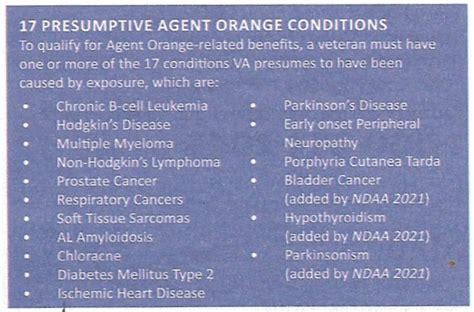Agent Orange Presumptive Conditions List

Introduction to Agent Orange and Its Effects

Agent Orange was a herbicide and defoliant used by the United States military during the Vietnam War. The name “Agent Orange” came from the orange-striped 55-gallon drums in which it was stored. The chemical was a mixture of two herbicides, 2,4-D and 2,4,5-T, and was contaminated with the highly toxic dioxin TCDD during its manufacture. Exposure to Agent Orange has been linked to a range of serious health problems, and the U.S. Department of Veterans Affairs (VA) has established a list of presumptive conditions associated with Agent Orange exposure.
What Are Presumptive Conditions?

Presumptive conditions are diseases or disabilities that the VA presumes are related to military service, in this case, exposure to Agent Orange. If a veteran has one of these conditions and can show they were exposed to Agent Orange during their military service, they may be eligible for disability compensation and other benefits without having to prove a direct link between their condition and their military service.
Agent Orange Presumptive Conditions List

The following conditions are presumed to be associated with exposure to Agent Orange:
- AL Amyloidosis: A rare disease caused by an abnormal protein (amyloid) that accumulates in various organs and tissues of the body.
- Chloracne (or similar acneform disease): A skin condition characterized by comedones, papules, pustules, and cysts.
- Chronic B-cell Leukemias: A type of cancer that affects the blood and bone marrow.
- Chronic Lymphocytic Leukemia (CLL): A type of cancer that affects the blood and bone marrow.
- Diabetes Mellitus Type 2: A disease characterized by high levels of blood sugar, which can lead to a variety of complications if left untreated or poorly managed.
- Hodgkin’s Disease: A type of lymphoma, a cancer originating from white blood cells called lymphocytes.
- Ischemic Heart Disease: A condition characterized by a reduced blood flow to the heart due to a blockage in the arteries, leading to heart attacks, heart failure, and other complications.
- Multiple Myeloma: A type of blood cancer characterized by the proliferation of malignant plasma cells in the bone marrow.
- Non-Hodgkin’s Lymphoma: A group of cancers that originate from the lymphocytes, a type of white blood cell.
- Parkinson’s Disease: A neurodegenerative disorder that affects movement, leading to symptoms such as tremors, stiffness, and slowed movement.
- Peripheral Neuropathy, Early-Onset: Damage to the peripheral nerves, which can cause weakness, numbness, and pain, typically in the hands and feet.
- Porphyria Cutanea Tarda: A disorder characterized by a deficiency of the enzyme responsible for the production of heme, a vital molecule for all of the body’s organs.
- Prostate Cancer: A common type of cancer that affects men, originating in the prostate gland.
- Respiratory Cancers (including Lung Cancer): Cancers of the lung, larynx, trachea, and bronchus.
- Soft Tissue Sarcoma (other than osteosarcoma, chondrosarcoma, Kaposi’s sarcoma, or mesothelioma): A group of cancers that originate in the soft tissues of the body, such as muscles, fat, and blood vessels.
Establishing Eligibility for Benefits

To be eligible for benefits related to Agent Orange exposure, veterans must show that they were exposed to the chemical during their military service and have a condition presumed to be associated with that exposure. The VA recognizes several groups of veterans as being at risk for Agent Orange exposure, including those who served in Vietnam between January 9, 1962, and May 7, 1975, and those who served in or near the Korean Demilitarized Zone (DMZ) between April 1, 1968, and August 31, 1971.
📝 Note: The process of establishing eligibility for benefits can be complex, and veterans or their families should consult with the VA or a veterans service organization for detailed guidance and support.
Importance of Medical Documentation

Medical documentation is crucial for veterans seeking compensation for Agent Orange-related conditions. Veterans should ensure that their medical records accurately reflect their condition and any treatments they have received. The VA will review these records as part of the claims process to determine eligibility for benefits.
| Condition | Description |
|---|---|
| AL Amyloidosis | A rare disease affecting various organs and tissues. |
| Chloracne | A skin condition characterized by acne-like symptoms. |
| Chronic B-cell Leukemias | A type of cancer affecting the blood and bone marrow. |
| Diabetes Mellitus Type 2 | A disease characterized by high blood sugar levels. |
| Hodgkin's Disease | A type of lymphoma, a cancer of the lymphatic system. |
| Ischemic Heart Disease | A condition characterized by reduced blood flow to the heart. |
| Multiple Myeloma | A type of blood cancer characterized by the proliferation of malignant plasma cells. |
| Non-Hodgkin's Lymphoma | A group of cancers originating from the lymphocytes. |
| Parkinson's Disease | A neurodegenerative disorder affecting movement. |
| Peripheral Neuropathy, Early-Onset | Damage to the peripheral nerves, causing weakness, numbness, and pain. |
| Porphyria Cutanea Tarda | A disorder characterized by a deficiency of the enzyme responsible for heme production. |
| Prostate Cancer | A common type of cancer affecting men, originating in the prostate gland. |
| Respiratory Cancers | Cancers of the lung, larynx, trachea, and bronchus. |
| Soft Tissue Sarcoma | A group of cancers originating in the soft tissues of the body. |

In summary, the list of presumptive conditions associated with Agent Orange exposure is extensive and includes various types of cancer, neurological diseases, and other serious health issues. Veterans who believe they may have been exposed to Agent Orange and are suffering from one of these conditions should consult with the VA to explore their eligibility for benefits. The process involves demonstrating exposure to Agent Orange and having a condition presumed to be related to that exposure. Accurate medical documentation is essential for a successful claim. By understanding the presumptive conditions list and the eligibility criteria, veterans can navigate the benefits process more effectively and receive the support they need.
What is Agent Orange?

+
Agent Orange was a herbicide and defoliant used by the U.S. military during the Vietnam War, known for its toxic effects, including dioxin contamination.
How do I know if I was exposed to Agent Orange?

+
Veterans who served in Vietnam between January 9, 1962, and May 7, 1975, or in the Korean DMZ between April 1, 1968, and August 31, 1971, may have been exposed. Consult with the VA for specific guidance.
What benefits are available for Agent Orange exposure?

+
Veterans exposed to Agent Orange and diagnosed with a presumptive condition may be eligible for disability compensation, healthcare, and other benefits from the VA.



